1
�
前言
本书全面介绍了 C++ 语言。作为一本入门书(Primer),它以教程的形式
对 C++ 语言进行清晰的讲解,并辅以丰富的示例和各种学习辅助手段。与大多
数入门教程不同,本书对 C++ 语言本身进行了详尽的描述,并特别着重介绍了
目前通行的、行之有效的程序设计技巧。
无数程序员曾使用本书的前几个版本学习 C++,在此期间 C++ 也逐渐发展
成熟。这些年来,C++ 语言的发展方向以及 C++ 程序员的关注点,已经从以往
注重运行时的效率,转到千方百计地提高程序员的编程效率上。随着标准库的广
泛可用,我们现在能够比以往任何时候更高效地学习和使用 C++。本书这一版本
充分体现了这一点。
第四版的改动
为了体现现代 C++ 编程风格,我们重新组织并重写了本书。书中不再强调
低层编程技术,而把中心转向标准库的使用。书中很早就开始介绍标准库,示例
也已经重新改写,充分利用了标准库设施。我们也对语言主题叙述的先后次序进
行了重新编排,使讲解更加流畅。
除重新组织内容外,为了便于读者理解,我们还增加了几个新的环节。每一
章都新增了“小结”和“术语”,概括本章要点。读者可以利用这些部分进行自
我检查;如果发现还有不理解的概念,可以重新学习该章中的相关部分。
书中还加入了下述几种学习辅助手段:
• 重要术语用黑体表示,我们认为读者已经熟悉的重要术语则用楷体表示。
这些术语都会出现在的“术语”部分。
• 书中用特殊版式突出标注的文字,是为了向读者提醒语言的重要特征,警
示常见的错误,标明良好的编程实践,列出通用的使用技巧。希望这些标
注可以帮助读者更快地消化重要概念,避免犯常见错误。
• 为了更易于理解各种特征或概念间的关系,书中大量使用了前后交叉引
用。
• 对于某些重要概念和 C++ 新手最头疼的问题,我们进行了额外的讨论和
解释。这部分也以特殊版式标出。
• 学习任何程序设计语言都需要编写程序。因此,本提供了大量的示例。所
有示例的源代码可以从下列网址获得:
• http://www.awprofessional.com/cpp_primer
万变不离其宗,本书保持了前几版的特色,仍然是一部全面介绍 C++ 的教程。
我们的目标是提供一本清晰、全面、准确的指南性读物。我们通过讲解一系列示
例来教授 C++ 语言,示例除了解释语言特征外,还展示了如何善用这门语言。
2
�
虽然读者不需要事先学过 C 语言(C++ 最初的基础)的知识,但我们假定读者
已经掌握了一种现代结构化语言。
本书结构
本介绍了 C++ 国际标准,既涵盖语言的特征,又讲述了也是标准组成部分
的丰富标准库。C++ 的强大很大程度上来自它支持抽象程序设计。要学会用 C++
高效地编程,只是掌握句法和语义是远远不够的。我们的重点在于,教会读者怎
样利用 C++ 的特性,快速地写出安全的而且性能可与 C 语言低层程序相媲美的
程序。
C++ 是一种大型的编程语言,这可能会吓倒一些新手。现代 C++ 可以看成由
以下三部分组成:
• 低级语言,多半继承自 C。
• 更高级的语言特征,用户可以借此定义自己的数据类型,组织大规模的程
序和系统。
• 标准库,使用上述高级特征提供一整套有用的数据结构和算法。
多数 C++ 教材按照下面的顺序展开:先讲低级细节,再介绍更高级的语言特
征;在讲完整个语言后才开始解释标准库。结果往往使读者纠缠于低级的程序设
计问题和复杂类型定义的编写等细节,而不能真正领会抽象编程的强大,更不用
说学到足够的知识去创建自己的抽象了。
本版中我们独辟蹊径。一开始就讲述语言的基础知识和标准库,这样读者就
可以写出比较大的有实际意义的程序来。透彻阐释了使用标准库(并且用标准库
编写了各种抽象程序)的基础知识之后,我们才进入下一步,学习用 C++ 的其
他高级特征来编写自己的抽象。
第一和第二部分讨论语言的基础知识和标准库设施。其重点在于学会如何编
写 C++ 程序,如何使用标准库提供的抽象设施。大部分 C++ 程序员需要了解本
书这两部分的内容。
除了讲解基础知识以外,这两部分还有另外一个重要的意图。标准库设施本
身是用 C++ 编写的抽象数据类型,定义标准库使用的是任何 C++ 程序员都能使
用的构造类的语言特征。我们教授 C++ 的经验说明,一开始就使用设计良好的
抽象类型,读者会更容易理解如何建立自己的类型。
第三到第五部分着重讨论如何编写自己的类型。第三部分介绍 C++ 的核心,
即对类的支持。类机制提供了编写自定义抽象的基础。类也是第四部分中讨论的
面向对象编程和泛型编程的基础。全书正文的最后是第五部分,这一部分讨论了
一些高级特征,它们在构建大型复杂系统时最为常用。
3
�
致谢
与前几版一新,我们要感谢 Bjarne Stroustrup,他不知疲倦地从事着 C++
方面的工作,他与我们的深厚友情由来已久。我们还要感谢 Alex Stepanov,正
是他最初凭借敏锐的洞察力创造了容器和算法的概念,这些概念最终形成了标准
库的核心。此外,我们要感谢 C++ 标准委员会的所有成员,他们多年来为 C++ 澄
清概念、细化标准和改进功能付出了艰苦的努力。
我们要衷心地感谢本书审稿人,他们审阅了我们的多份书稿,帮助我们对本
书进行了无数大大小小的修改。他们是 Paul Abrahams,Michael Ball,Mary
Dageforde,Paul DuBois,Matt Greenwood,Matthew P. Johnson,Andrew Koenig,
Nevin Liber,Bill Locke,Robert Murray,Phil Romanik,Justin Shaw,Victor
Shtern,Clovis Tondo,Daveed Vandevoorde 和 Steve Vinoski。
书中所有示例都已通过 GNU 和微软编译器的编译。感谢他们的开发者和所
有开发其他 C++ 编译器的人,是他们使 C++ 变成现实。
最后,感谢 的工作人员,他们引领了这一版的整个出版过程:——我们最
初的编辑,是他提出出版本书的新版,他从本书最初版本起就一直致力于本书;
——我们的新编辑,他坚持更新和精简本书内容,极大地改进了这一版本;——
他保证了我们所有人能按进度工作;还有 、、和,他们和我们一起经历了整个
设计和制作过程。
4
�
目录
前言 ..................................................................................................................................................1
第四版的改动...........................................................................................................................2
本书结构...................................................................................................................................3
致谢...........................................................................................................................................4
第一章 快速入门...........................................................................................................................17
1.1. 编写简单的 C++ 程序..........................................................................................17
调用 GNU 或微软编译器 ....................................................................................................20
Exercises Section 1.1.1 ...........................................................................................................21
1.2. 初窥输入/输出........................................................................................................21
关键概念:已初始化变量和未初始化变量.........................................................................26
Exercises Section 1.2.2 ...........................................................................................................27
1.3. 关于注释.................................................................................................................27
Exercises Section 1.3 ......................................................................................................29
1.4. 控制结构.................................................................................................................29
关键概念:C++ 程序的缩排和格式....................................................................................31
再谈编译.................................................................................................................................34
Exercises Section 1.4.2 ...........................................................................................................35
Exercises Section 1.4.3 ...........................................................................................................37
从键盘输入文件结束符.........................................................................................................39
Exercises Section 1.4.4 ...........................................................................................................39
1.5. 类的简介.................................................................................................................39
关键概念:类定义行为.........................................................................................................42
Exercises Section 1.5.1 ...........................................................................................................43
Exercises Section 1.5.2 ...........................................................................................................45
1.6. C++ 程序 ................................................................................................................45
Exercises Section 1.6 ..............................................................................................................47
小结.................................................................................................................................47
术语.................................................................................................................................47
第一部分 基本语言.......................................................................................................................54
第二章 变量和基本类型.......................................................................................................55
2.1. 基本内置类型.........................................................................................................55
内置类型的机器级表示.........................................................................................................57
建议:使用内置算术类型.....................................................................................................60
Exercises Section 2.1.2 ...........................................................................................................61
2.2. 字面值常量.............................................................................................................61
建议:不要依赖未定义行为.................................................................................................66
Exercises Section 2.2 ..............................................................................................................67
2.3. 变量.........................................................................................................................67
Exercises Section 2.3 ..............................................................................................................68
关键概念:强静态类型.........................................................................................................69
Exercises Section 2.3.1 ...........................................................................................................70
5
�
术语:什么是对象?.............................................................................................................71
Exercises Section 2.3.2 ...........................................................................................................73
Exercises Section 2.3.3 ...........................................................................................................77
警告:未初始化的变量引起运行问题.................................................................................78
Exercises Section 2.3.4 ...........................................................................................................79
Exercises Section 2.3.5 ...........................................................................................................81
Exercises Section 2.3.6 ...........................................................................................................84
2.4. const 限定符 ...........................................................................................................84
Exercises Section 2.4 ..............................................................................................................87
2.5. 引用.........................................................................................................................87
术语:const 引用是指向 const 的引用...........................................................................89
Exercises Section 2.5 ..............................................................................................................90
2.6. typedef 名字............................................................................................................90
2.7. 枚举.........................................................................................................................91
2.8. 类类型.....................................................................................................................93
Exercises Section 2.8 ..............................................................................................................97
2.9. 编写自己的头文件.................................................................................................97
编译和链接多个源文件.........................................................................................................99
Exercises Section 2.9.1 .........................................................................................................102
小结...............................................................................................................................104
术语...............................................................................................................................105
第三章 标准库类型.............................................................................................................112
3.1. 命名空间的 using 声明 ........................................................................................112
Exercises Section 3.1 ............................................................................................................115
3.2. 标准库 string 类型................................................................................................115
警告:标准库 string 类型和字符串字面值.....................................................................116
Exercises Section 3.2.1 .........................................................................................................116
Exercises Section 3.2.2 .........................................................................................................119
建议:采用 C 标准库头文件的 C++ 版本.........................................................................127
Exercises Section 3.2.4 .........................................................................................................127
3.3. 标准库 vector 类型.............................................................................................127
关键概念:vector 对象动态增长.....................................................................................130
Exercises Section 3.3.1 .........................................................................................................131
关键概念:安全的泛型编程...............................................................................................134
警告:仅能对确知已存在的元素进行下标操作...............................................................135
Exercises Section 3.3.2 .........................................................................................................136
3.4. 迭代器简介...........................................................................................................136
术语:迭代器和迭代器类型...............................................................................................137
Exercises Section 3.4 ............................................................................................................142
Exercises Section 3.4.1 .........................................................................................................143
3.5. 标准库 bitset.........................................................................................................143
Exercises Section 3.5.2 .........................................................................................................150
小结...............................................................................................................................150
术语...............................................................................................................................150
6
�
第四章 数组和指针.............................................................................................................155
4.1. 数组.......................................................................................................................155
警告:数组的长度是固定的...............................................................................................159
Exercises Section 4.1.1 .........................................................................................................160
Exercises Section 4.1.2 .........................................................................................................162
4.2. 指针的引入...........................................................................................................162
建议:尽量避免使用指针和数组.......................................................................................163
Exercises Section 4.2.2 .........................................................................................................169
关键概念:给指针赋值或通过指针进行赋值...................................................................170
Exercises Section 4.2.3 .........................................................................................................172
Exercises Section 4.2.4 .........................................................................................................177
建议:理解复杂的 const 类型的声明.............................................................................180
Exercises Section 4.3 ............................................................................................................182
4.3. C 风格字符串 .......................................................................................................182
Exercises Section 4.3 ............................................................................................................188
C 风格字符串与 C++ 的标准库类型 string 的比较 ...................................................192
Exercises Section 4.3.1 .........................................................................................................194
Exercises Section 4.3.2 .........................................................................................................196
4.4. 多维数组...............................................................................................................196
Exercises Section 4.4.1 .........................................................................................................200
小结...............................................................................................................................200
术语...............................................................................................................................200
第五章 表达式.....................................................................................................................204
5.1. 算术操作符...........................................................................................................205
警告:溢出和其他算术异常...............................................................................................207
Exercises Section 5.1 ............................................................................................................209
5.2. 关系操作符和逻辑操作符...................................................................................209
Exercises Section 5.2 ............................................................................................................213
5.3. 位操作符...............................................................................................................213
Exercises Section 5.3.1 .........................................................................................................217
5.4. 赋值操作符...........................................................................................................218
Exercises Section 5.4.2 .........................................................................................................221
Exercises Section 5.4.3 .........................................................................................................222
5.5. 自增和自减操作符...............................................................................................222
建议:只有在必要时才使用后置操作符...........................................................................223
建议:简洁即是美...............................................................................................................224
Exercises Section 5.5 ............................................................................................................225
5.6. 箭头操作符...........................................................................................................225
Exercises Section 5.6 ............................................................................................................226
5.7. 条件操作符...........................................................................................................226
Exercises Section 5.7 ............................................................................................................228
5.8. sizeof 操作符 ........................................................................................................228
Exercises Section 5.8 ............................................................................................................229
5.9. 逗号操作符...........................................................................................................229
7
�
Exercises Section 5.9 ............................................................................................................230
5.10. 复合表达式的求值.............................................................................................230
Exercises Section 5.10.2 .......................................................................................................236
建议:复合表达式的处理...................................................................................................238
Exercises Section 5.10.3 .......................................................................................................239
5.11. new 和 delete 表达式........................................................................................239
警告:动态内存的管理容易出错.......................................................................................243
Exercises Section 5.11 ..........................................................................................................244
5.12. 类型转换.............................................................................................................244
Exercises Section 5.12.3 .......................................................................................................250
建议:避免使用强制类型转换...........................................................................................253
Exercises Section 5.12.7 .......................................................................................................255
小结...............................................................................................................................255
术语...............................................................................................................................256
第六章 语句.........................................................................................................................261
6.1. 简单语句...............................................................................................................261
6.2. 声明语句...............................................................................................................262
6.3. 复合语句(块)...................................................................................................263
Exercises Section 6.3 ............................................................................................................264
6.4. 语句作用域.........................................................................................................264
6.5. if 语句 ...................................................................................................................265
Exercises Section 6.5.1 .........................................................................................................270
6.6. switch 语句 ...........................................................................................................270
Exercises Section 6.6.5 .........................................................................................................278
Code for Exercises in Section 6.6.5 ......................................................................................278
6.7. while 语句.............................................................................................................279
Exercises Section 6.7 ............................................................................................................282
6.8. for 循环语句.........................................................................................................282
Exercises Section 6.8.2 .........................................................................................................286
6.9. do while 语句........................................................................................................286
Exercises Section 6.9 ............................................................................................................289
6.10. break 语句...........................................................................................................289
Exercises Section 6.10 ..........................................................................................................291
6.11. continue 语句 ......................................................................................................291
Exercises Section 6.11 ..........................................................................................................292
6.12. goto 语句.............................................................................................................292
Exercises Section 6.12 ..........................................................................................................293
6.13. try 块和异常处理 ...............................................................................................293
Exercises Section 6.13.2 .......................................................................................................297
6.14. 使用预处理器进行调试.....................................................................................299
Exercises Section 6.14 ..........................................................................................................301
小结...............................................................................................................................301
术语...............................................................................................................................302
第七章 函数.........................................................................................................................306
8
�
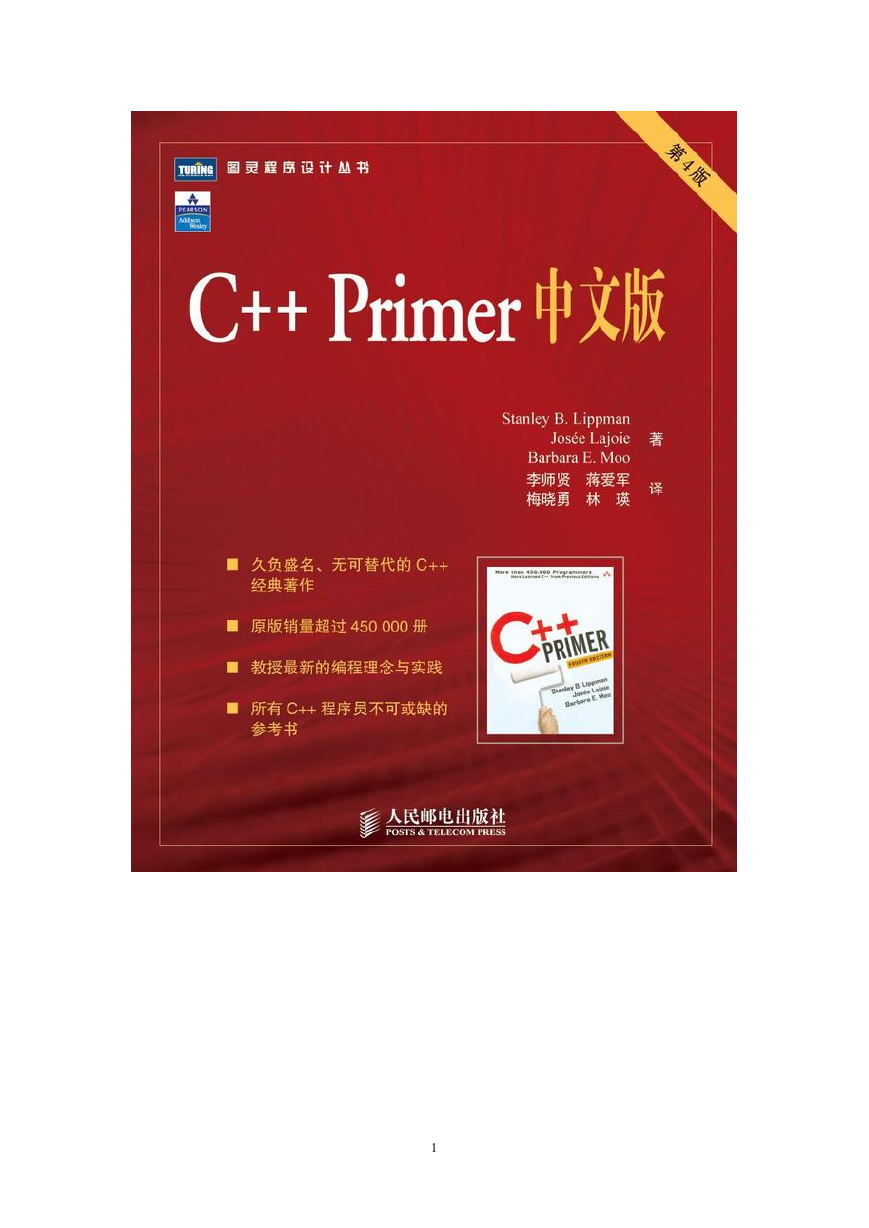
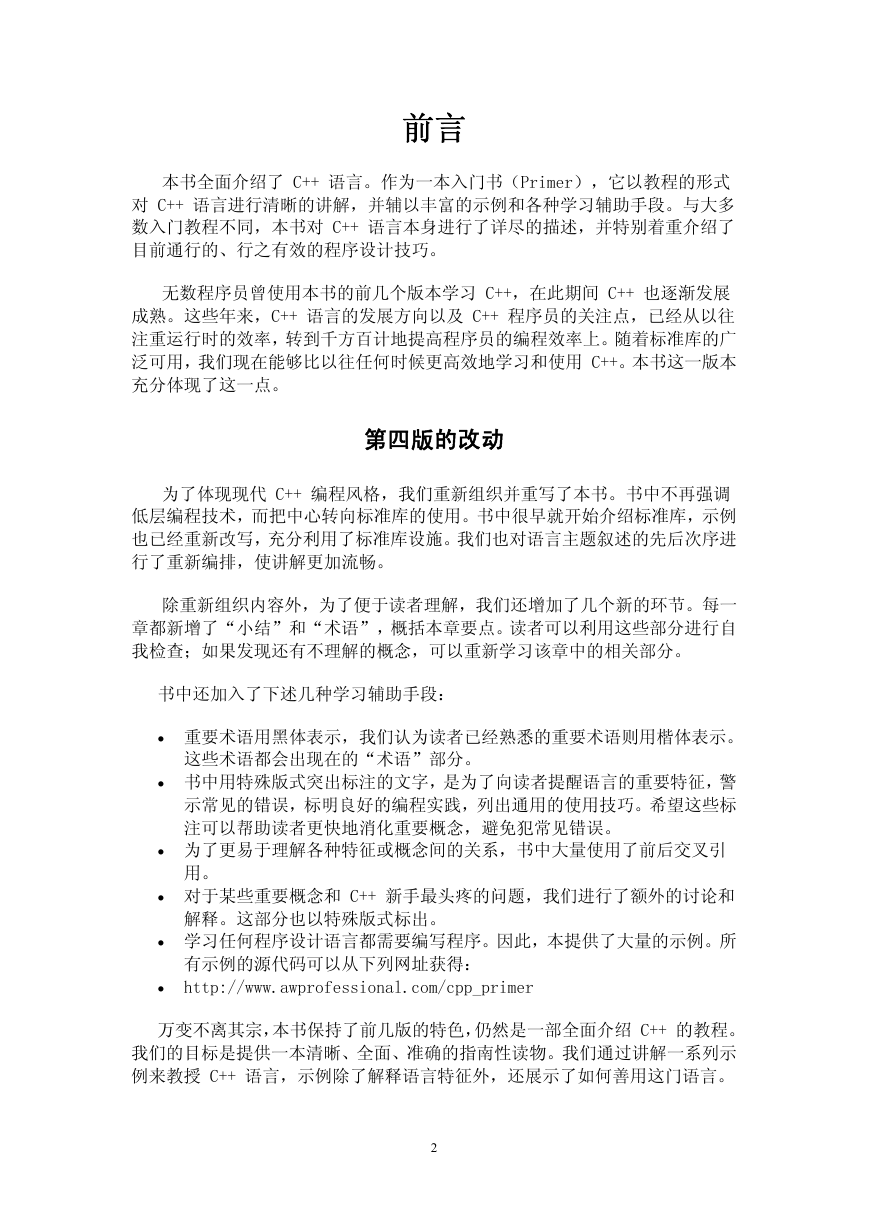

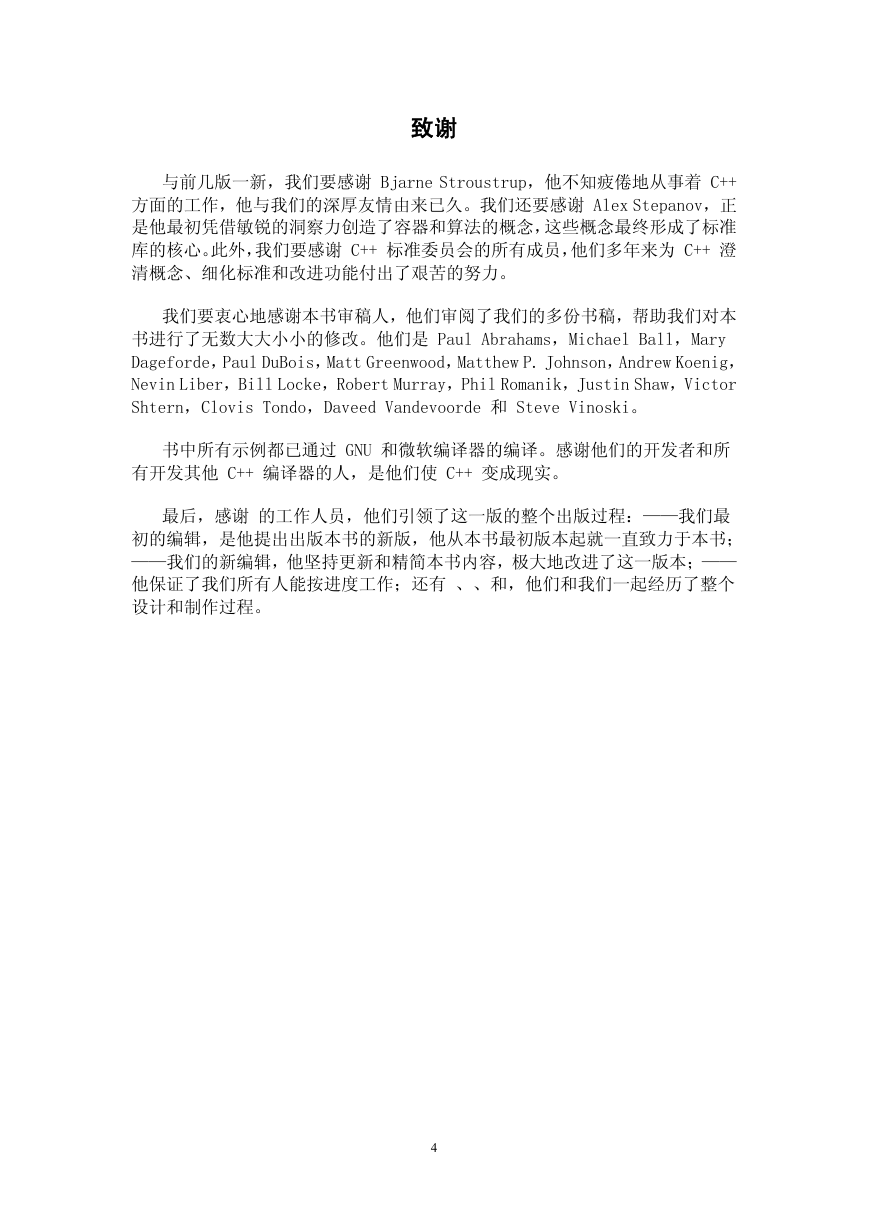
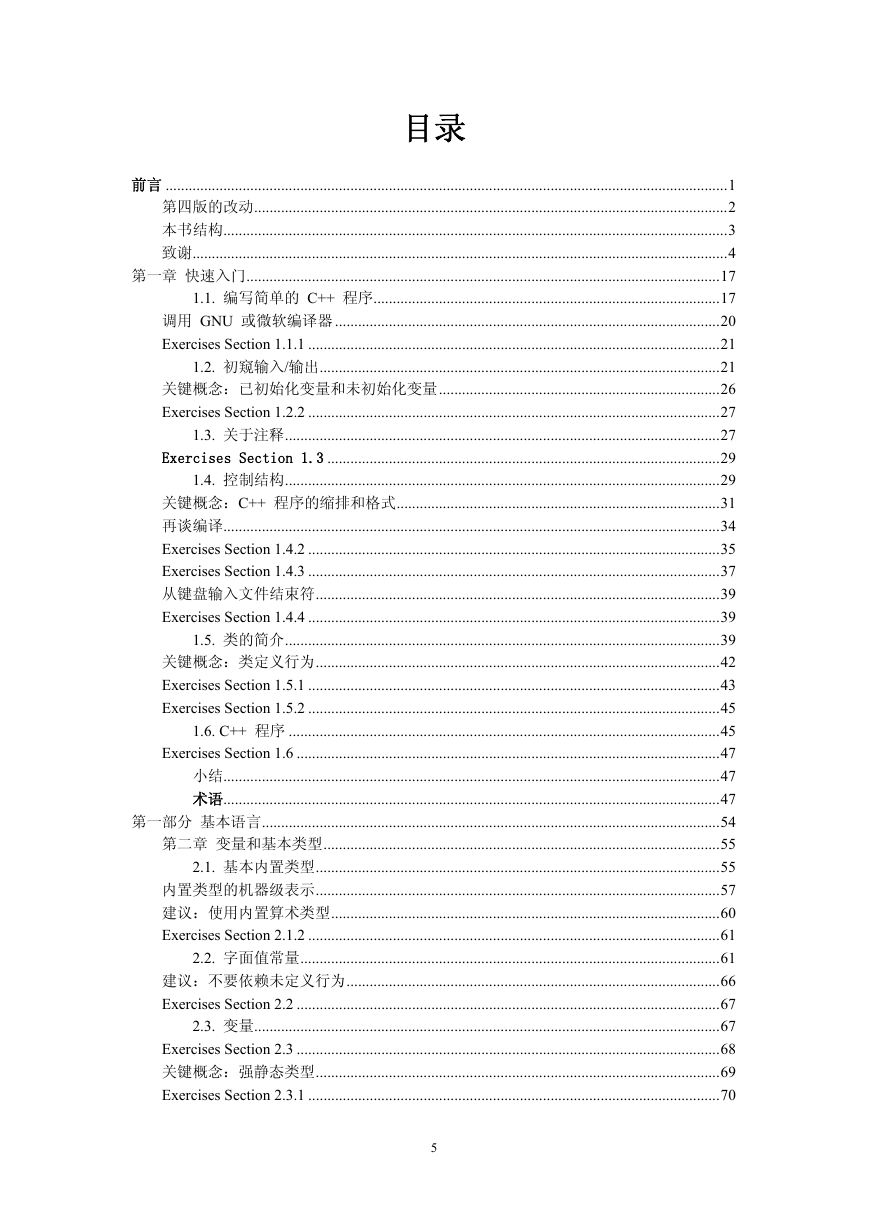
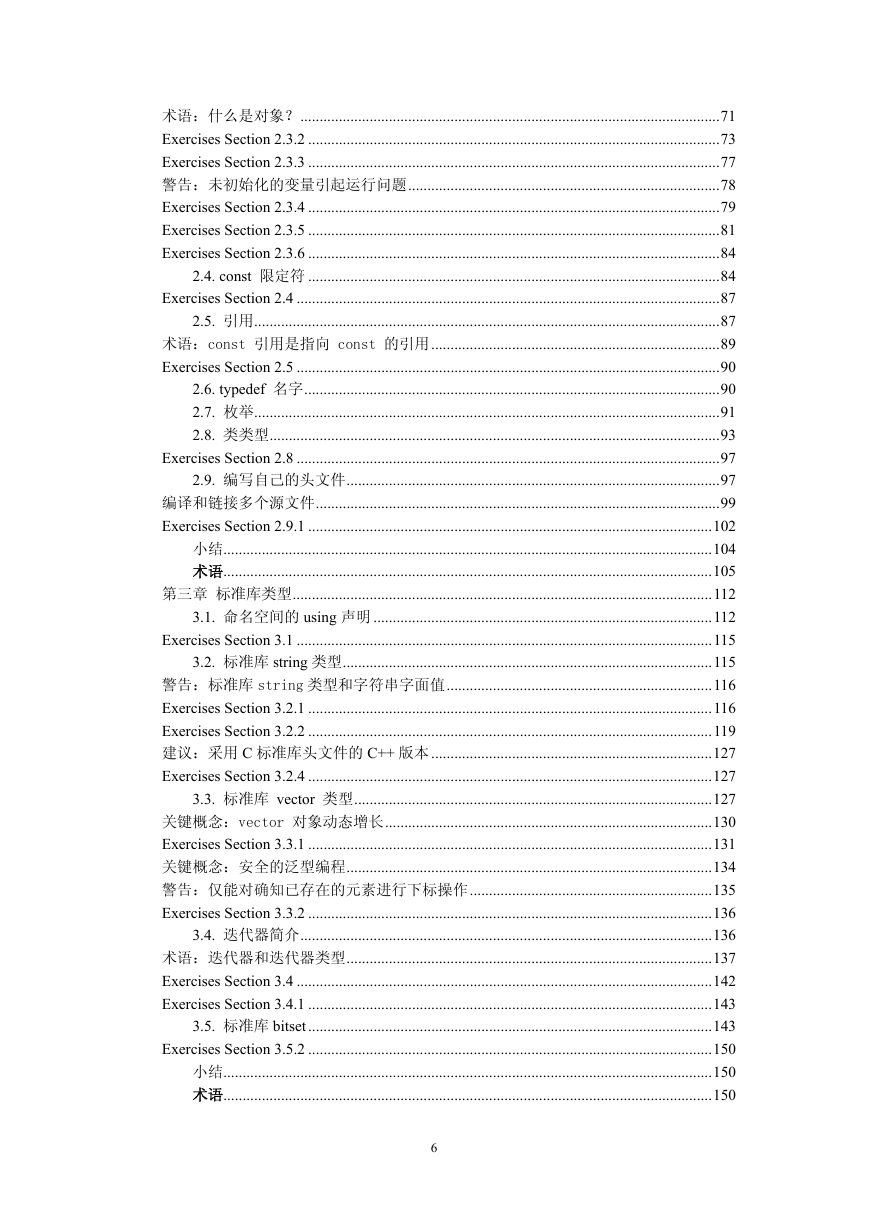
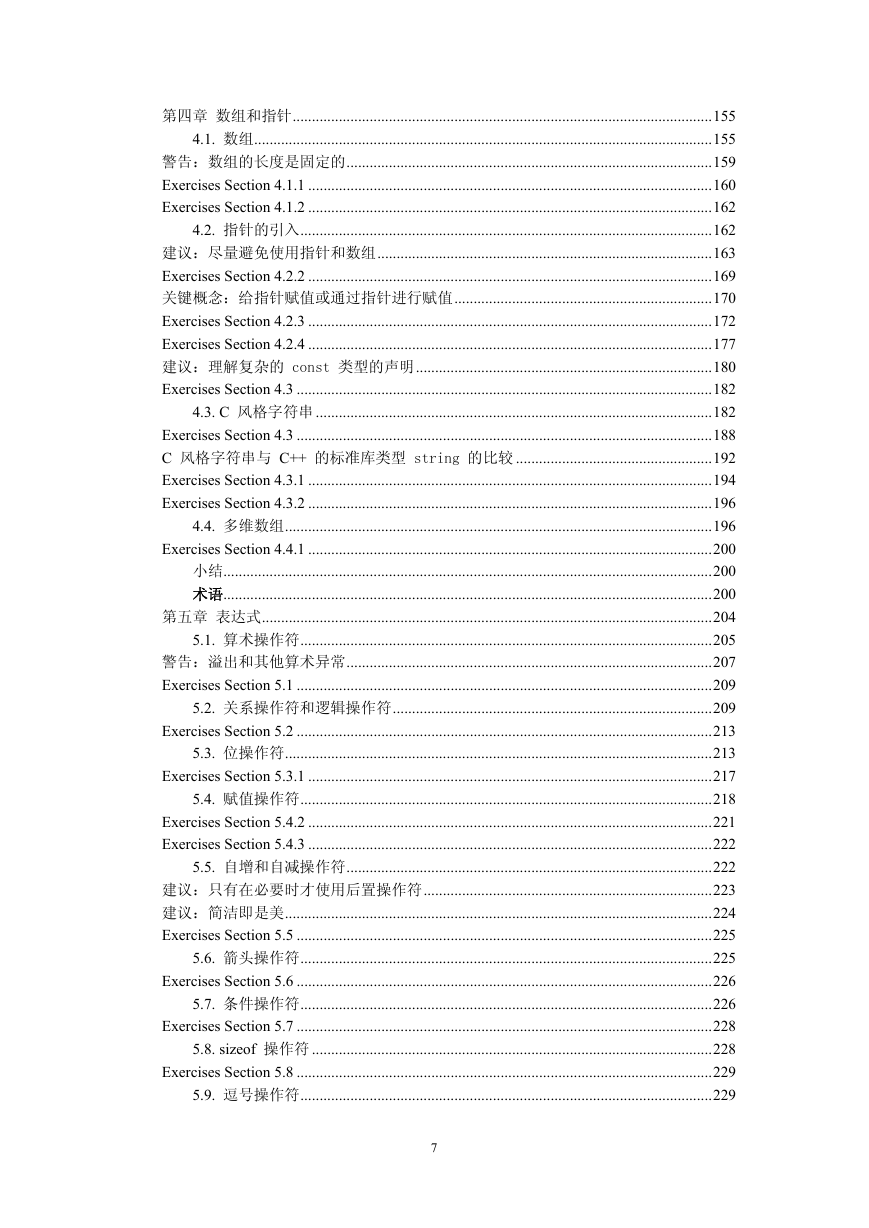
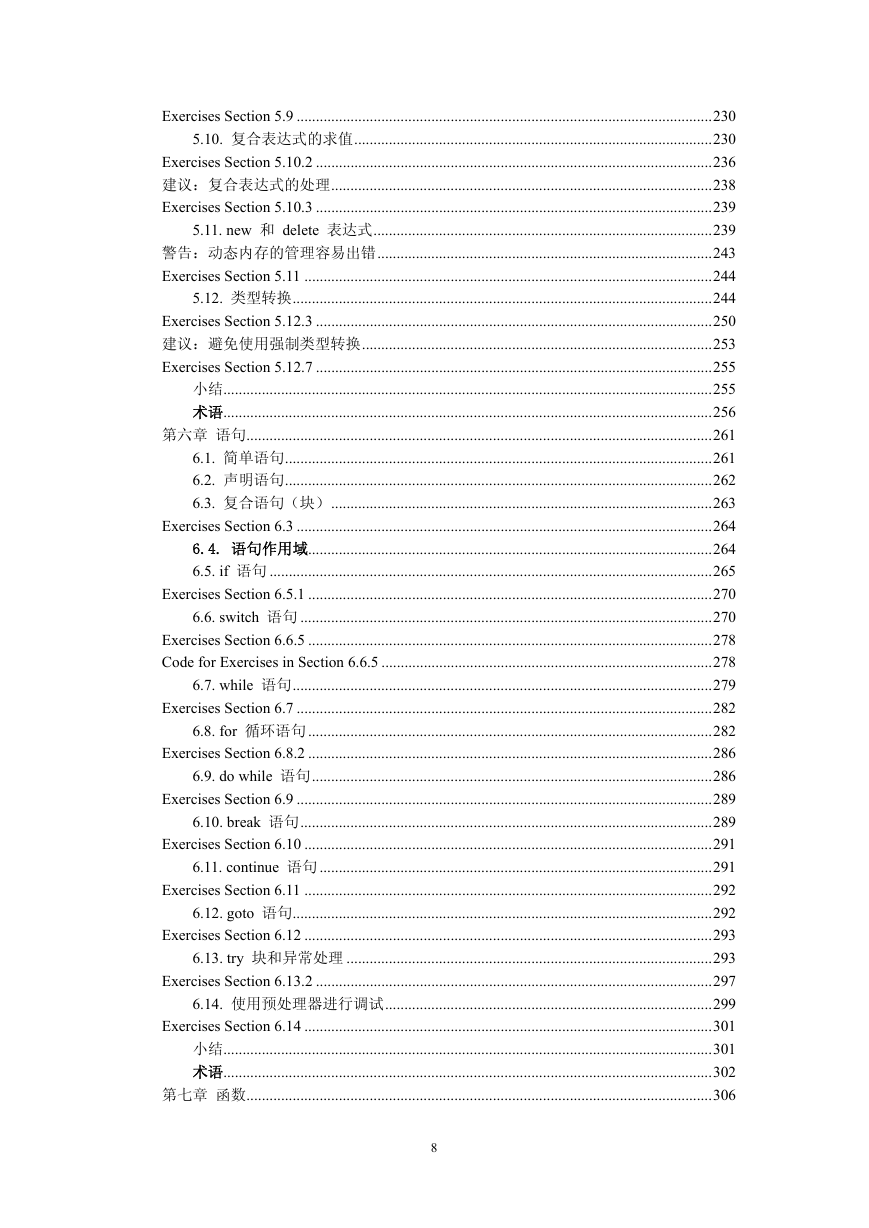








 2023年江西萍乡中考道德与法治真题及答案.doc
2023年江西萍乡中考道德与法治真题及答案.doc 2012年重庆南川中考生物真题及答案.doc
2012年重庆南川中考生物真题及答案.doc 2013年江西师范大学地理学综合及文艺理论基础考研真题.doc
2013年江西师范大学地理学综合及文艺理论基础考研真题.doc 2020年四川甘孜小升初语文真题及答案I卷.doc
2020年四川甘孜小升初语文真题及答案I卷.doc 2020年注册岩土工程师专业基础考试真题及答案.doc
2020年注册岩土工程师专业基础考试真题及答案.doc 2023-2024学年福建省厦门市九年级上学期数学月考试题及答案.doc
2023-2024学年福建省厦门市九年级上学期数学月考试题及答案.doc 2021-2022学年辽宁省沈阳市大东区九年级上学期语文期末试题及答案.doc
2021-2022学年辽宁省沈阳市大东区九年级上学期语文期末试题及答案.doc 2022-2023学年北京东城区初三第一学期物理期末试卷及答案.doc
2022-2023学年北京东城区初三第一学期物理期末试卷及答案.doc 2018上半年江西教师资格初中地理学科知识与教学能力真题及答案.doc
2018上半年江西教师资格初中地理学科知识与教学能力真题及答案.doc 2012年河北国家公务员申论考试真题及答案-省级.doc
2012年河北国家公务员申论考试真题及答案-省级.doc 2020-2021学年江苏省扬州市江都区邵樊片九年级上学期数学第一次质量检测试题及答案.doc
2020-2021学年江苏省扬州市江都区邵樊片九年级上学期数学第一次质量检测试题及答案.doc 2022下半年黑龙江教师资格证中学综合素质真题及答案.doc
2022下半年黑龙江教师资格证中学综合素质真题及答案.doc